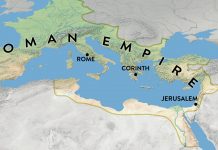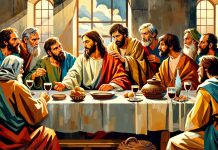Given that no one could become a scholar without formal training, it is truly remarkable that Jesus, who was not formally educated, was nevertheless recognized as a “Rabbi” (Mark 12:14 cf. John 3:2).[1]
The Gospel of John suggests that Jesus never received formal education in rabbinical schools (John 7:15). However, we find Him writing, reading, debating with the Pharisees and scholars, which suggests that He was instructed by His parents. In more than 40 passages, the Gospels call Jesus a teacher.[2] Usually, the title is used as a form of address by those who came to talk to Jesus, but in some passages, Jesus identifies Himself with this title (Matthew 23:8 cf. Matthew 10:24-25; John 13:13-14). Teaching (or preaching) was one of the most important components of Jesus’s three-and-a-half-year long mission.
Similarities between Jesus and the scholars
Robert Stein[3] summarises the similarities between Jesus and the scholars as follows:
- Jesus proclaimed the divine law as other teachers did (Mark 12:28-34), and taught in synagogues (Mark 1:21-28, 39; 3:1-6; 6:1-6),
- He was followed by disciples (Mark 1:16-20; 3:13-19 cf. John 1:35-51),
- He debated with other scholars according to the manner in which they debated under the same authority given by the Scriptures (Mark 7:5; 11:27-33; 12:13-17, 18-27),
- Jesus was challenged to engage in legal disputes that scholars naturally dealt with (Mark 12:13-17; Luke 12:13-15; cf. John 8:1-11),
- He sat down while teaching others according to the custom of the scholars (Matthew 5:1 cf. and Luke 2:46; Mark 4:1; 9:35; Luke 4:20),
- He supported His teaching with the Scriptures (Matthew 12:40; 18:16; Mark 2:25-26; 4:12; 10:6-8, 19; 12:26, 29-31, 36),
- He used poetic-didactic techniques to help His disciples retain His teachings.
Differences between Jesus and the scholars
Despite these similarities, when the reader comes into contact with the gospels, the immediate impression is that the natural focus is on the differences rather than on the similarities between Jesus and the scholars.
First, many noticed that Jesus’s association with women and children, or with publicans and sinners, was extremely unusual for an official scholar (Matthew 11:16-19; Mark 2:14-17; 10:13-16; Luke 7:39; 15:1-2).[4]
Second, in Mark 1:17, Jesus’s words suggest that He recruited His disciples and that this was not the common practice for a scholar.[5]
Third, “Normally a pupil (talmid) was a disciple of the tradition of his teacher, but the disciples of Jesus were exactly that—disciples of Jesus. Their message was not just the words of Jesus, although they did ‘receive’ and thus now ‘delivered’ his words”.[6]
Lastly, although Jesus taught in the synagogues like the rabbis, His originality is seen in the fact that He also taught in rural areas, in the open fields, or by the lake.
The most important difference, however, lies in Jesus’s disinterest in gaining notoriety through His teachings or in seeking the perfect speech. Jesus had not come to give perfect speeches, but to offer Himself as a solution to people’s problems. He had come to be the Word, not to speak it.
From this point of view, Jesus’s teachings are only incidental compared to His great purpose. This explains why people perceived a great difference between the simplicity of Jesus’s words and the complicated nature of the rabbinic teachings.
“Even with questions of a most transparent character, [the rabbis’] treatment was full of subtle definitions and distinctions, recalling differing opinions on some trifling point of detail, and the most improbable hypotheses”.[7] In contrast, Jesus had a special ability to always focus on the central issue, on the heart of the matter (Matthew 12:30; Mark 9:40), without having to worry about setting theoretical frameworks and principles for the discussion.
Jesus’s speech
Jesus used a significant number of stylistic figures:
- exaggeration (the cutting off of the hand or gouging out of the eye from Matthew 5:29; turning the other cheek or going the extra mile when you are abused from Matthew 5:38-41),
- hyperbole (the gnat and the camel from Matthew 23:24; the speck of sawdust in Matthew 7:3-5; moving the mountains in Matthew 17:20; forgiving 490 times in Matthew 18:22; wandering the earth and the sea in Matthew 23:15),
- comparison (“I am sending you out like sheep among wolves.”—Matthew 10:16),
- metaphor (“you are the salt of the earth.”—Matthew 5:13),
- riddle (“I will destroy this temple made with human hands and in three days will build another, not made with hands”—Mark 14:58),
- metonymy (the sword in Matthew 10:34 represents war),
- paradox (“whoever wants to become great among you must be your servant”—Mark 10:43),
- irony (“You know how to interpret the appearance of the sky, but you cannot interpret the signs of the times”—Matthew 16:3)
- wordplay (“you are Peter, and on this rock I will build my church”—Matthew 16:18).
The way Jesus used questions and parables, along with the stylistic figures already listed, is characteristic of Semitic communication. Therefore, their significance is best understood when assessed in the Hebrew context.
Regarding the parables, we can distinguish four intentions with which they are used by Jesus.
First, Jesus sometimes uses parables to conceal His message in certain situations because of spies or a hostile audience (Mark 4:10-12).
The second intention is the opposite of the first—Jesus often uses parables to reveal His message and to make a lasting impression on the audience.
Jesus’s third intention can best be understood in comparison with the Old Testament parable given by the prophet Nathan to David, during which David practically ends up convicting himself (2 Samuel 12:1-14). Thus, many of Jesus’s parables convey unpopular messages in a way that does not provoke resistance.
Fourth, the parables of Jesus emphasise the importance of the natural world in the analogous understanding of the spiritual nature of the Kingdom of God. In short, the parables reveal God’s message to those who want to understand it and hide it from those with impure motives or intentions.
The uniqueness of Jesus
Thus, although according to some authors Jesus overwhelmingly[8] used images common to those used by Old Testament prophets and sage writers or rabbis, the way Jesus included and used these images in His message is deeply original, because He did not convert known images, but revealed original meanings, overlooked throughout history. He restored the meaning of ancient concepts in accordance with God’s revelation of Himself.
Thus, Jesus did not use the teaching methods of His time (proverbs, the answer to the question with a counter-question, figurative speech, parables, etc.) mechanically, but creatively, and that is why people felt the uniqueness of Jesus (“No one ever spoke the way this man does” John 7:46).
Jesus’s special spiritual experience, as described in the Gospels, is certainly a source of the uniqueness of His discourse. Thus, His words really were “the words of God” (John 3:34; 7:16; 8:26, 28; 12:49-50; 14:10, 24; 17:8), of which He Himself testified: “…my words will never pass away” (Matthew 24:35; Mark 13:31; Luke 21:33). This spiritual experience provided Jesus with an understanding of Scripture that amazed the audience (Matthew 17:24-27; 22:18; John 2:24-25; 4:10; 6:15, 64, 70-71). Therefore, the result of His words, some of which are seen as difficult or cryptic, was incomparable to that produced by the words of the scholars.
Norel Iacob shows that Jesus Christ was simultaneously a true Jew among the Jews, but also a unique teacher, whose words were always carefully chosen, universally valid, memorable, and revealing.



















